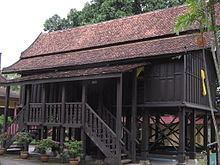 | ||
The Istana Satu (First Palace) was a royal residence in Kuala Terengganu in Malaysia.
History
It was erected by Sultan Zainal Abidin III, Sultan of Terengganu in 1884 in the compound of Kota Istana Maziah, Kuala Terengganu. This building is of Terengganu Malay traditional architecture, in the form called "Rumah Tiang Dua Belas". The wood used is cengal. Istana Satu was erected in the Muzium Negara compound in April 1974.
Rich Malay craftsmanship is evident throughout the palace, from the intricate wood carvings that adorn doors and windows. The restored palace is a charming wooden house designed for the tropics. Standing on stilts that allow air to circulate freely under the building, the palace’s steep thatch roof contributes further to keeping the interior of the house nice and cool.
The guest hall of the istana is furnished with a cupboard that is made of carved wood with gold inlaid and complete with a mirror. The cupboard is used to store small decorative items. A hanging lamp is positioned from ceiling. A brass foot tray with legs is placed in the hall of visitors. Spread out is a mat made out of mengkuang leaves, a Malay feature to honour guests. Adding to the royal ambience of the central hall are brass shields mounted on the left and right walls. The kitchen of the istana is made from wood carved with floral motifs. Arranged on the table are a food cover made of woven mengkuang leaves and brass tray symbolising the pride and identity of the Malay race, together with a glass lamp. The cupboard is where the kitchen utensils are stored. The decorative items are simple yet full of artistic and cultural meaning.
Standing next to the Istana Satu are two keliriengs or burial poles. A kelirieng is made of a huge hardwood tree trunk, carved from the top to bottom. Niched up to its sides is a space for the bodies of slaves and followers and hollowed at the top to place the jar containing the chief’s bones.
The istana is located today on the grounds of the National Museum of Malaysia.
